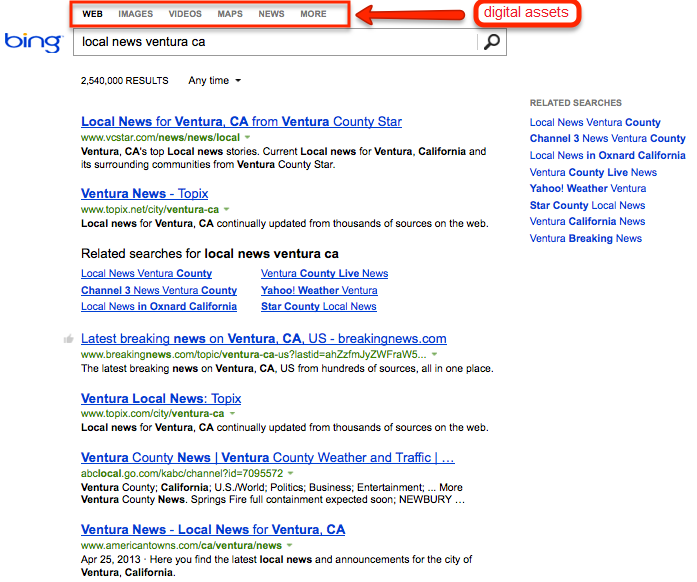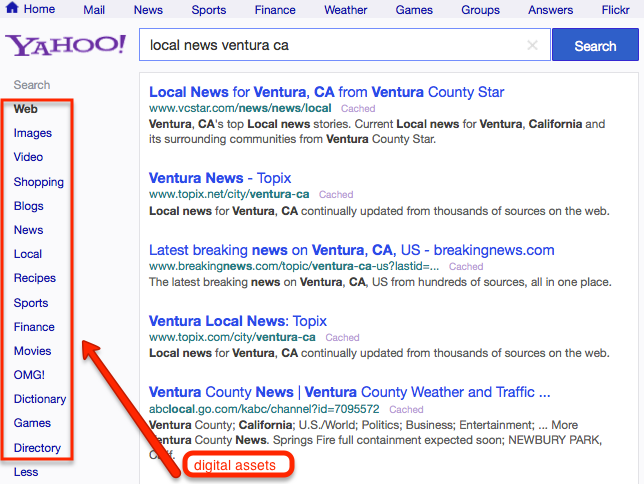Optimizing Your Digital Assets To Boost Rankings & Branding
Let’s say you’re responsible for developing revenues from both traditional and non-traditional advertising. You work with a digital staff of talented people to create lead-generating Web-based content, or perhaps you are in e-commerce and sell products. Maybe you’re a brick and mortar with a website, or perhaps a pure-play Internet business with no physical storefronts. […]
Let’s say you’re responsible for developing revenues from both traditional and non-traditional advertising. You work with a digital staff of talented people to create lead-generating Web-based content, or perhaps you are in e-commerce and sell products. Maybe you’re a brick and mortar with a website, or perhaps a pure-play Internet business with no physical storefronts.
Regardless of whether you are a newspaper (publisher), e-commerce (products) or franchise (services) site, performing well within the SERPs will always lead to new customer acquisition. By identifying and optimizing all of your digital assets, you can reach all of your prospective new customers and maximize performance.
The term “Digital Asset Optimization” (DAO) was first coined by my friend and longtime SEO, Lee Odden, back in July 2009. It ensures that we optimize content for all of our marketing collateral in all digital formats.
The process involves the optimization of digital assets throughout multiple digital content channels. This results in having all forms of your content visible in Google, Bing and Yahoo! as shown below for the term [local news ventura ca].
Optimization Based On User Intent
Your optimization efforts should reflect the many ways your customers search and convey their intent. It’s important to include all digital assets in your SEO efforts, even mobile apps and widgets, to increase the likelihood of reaching all potential customers during all phases of the search funnel. This not only helps boost your rankings, it can also achieve branding at the same time.
Marketers that leverage this process across all digital assets will connect to customer personas in every channel and format, performing effectively in today’s competitive environment. For more information about personas, see Shari Thurow’s How To Use Personas & Scenarios In SEO.
Digital Assets For Optimization
Below are some examples of digital assets you might want to consider for optimization. This list may not be exhaustive but includes all I can think of at the moment.
- Web pages (store location pages, category pages, product pages, reviews, holiday promotions, sitemaps, semantic mark up)
- Images (product images, infographic images, news images, article enhancement images)
- Location data (maps optimization, business data aggregators, Internet Yellow Pages)
- Feeds (product shopping feed, map data feed)
- Video (product videos, how-to videos, consumer generated videos, corporate interviews)
- News (Corporate, industry, new release information)
- Press Releases (corporate releases, newsworthy releases)
- Blogs (company blog, category blog, seasonal regional trends)
- Forums (product related, regional discussions)
- Articles (product use and description related, category related, seasonal regional information, industry trends)
- Social Media data (social API’s, customer service, product feedback, media relations, new product launch)
- Social Media sites (Facebook business page, Twitter account)
- Mobile Apps
- Podcasts (instructional educational audio books)
Optimizing Your Digital Assets
Digital asset optimization is about creating and optimizing content that compels customers to engage, respond and convert. There’s been a lot written about optimizing many of the assets suggested above. However, I’d like to cover two optimization techniques that would be very advantageous for you to employ: video optimization and mobile app optimization. Read on to find out why optimizing these assets can go a long way toward bringing you more traffic, conversions and brand recognition.
Video Optimization
Over 180 million Americans watched 39 billion+ online videos in March 2013, (comScore-Media Metrix). In 2012, online audiences watched video ads at a rate of over 150 per second (AdAge).
Eighty-five percent of the US Internet audience viewed online video in March 2013, and video ads accounted for 25 percent of all videos viewed (BrightRoll – pdf). Not only that, the survey found that 75% of ad agencies believed online video ads to be equally or more effective than TV ads. Significant percentages felt that videos ads were equally or more effective than display (91%), social media (68%), search (52%) and direct response (45%) as well.
A well-optimized video can not only bring you authoritative links, it can also achieve top listings in the SERPs, resulting in traffic and conversions. When creating video, carefully define your purpose. This might be to build links, generate social shares or increase conversions.
With so many videos on the Web, you’ll have to plan carefully to excel. If you want to go viral, try humor, be original and, most importantly, tailor your video to your target audience. Another popular option is the educational video, which works well for retail products. Below are some tips for video optimization.
- Host your video on your own website rather than on YouTube or Vimeo
- Include social share buttons on your video embed (“Like” and “Tweet” buttons for easy sharing)
- Use Rich Snippets by adding the required Schema.org code to your page for an eye-catching display in the SERPs
- Create and submit an XML video sitemap
- Promote your video on social media sites, through your blog/website, video PR, email (new products, promotions, contests, etc.)
- Use SEO best practices ( title tag, relevant tags, specific keywords, accurate description and full video transcript)
- For detailed video optimization, see ReelSEO’s Definitive Video SEO Guide
Mobile App Optimization
The use of mobile apps is growing rapidly. By 2012, mobile app store downloads totaled over 45.6 billion (Gartner). The Apple App Store and Google Play alone offer over 1.5 million downloadable apps.
Mobile analytics firm Flurry reports user time spent on apps has doubled from 1 hour a day in 2011 to 2 hours a day in 2013. While the time spent in apps may be starting to challenge television, Flurry compared U.S. app usage to traditional media and other online audience measurements, finding that “…app usage spikes during primetime to a peak of 52 million consumers.” Does this leave any doubt about the importance of optimizing mobile apps?
Normally, users search for apps in two places: app stores and/or search engines. Optimizing your mobile apps to be easily found is similar to optimizing your website.
Website SEO gets your site crawled by optimizing on-page and off-page elements while building authority through links and social media. However, in mobile app SEO, you want to optimize the page on which your app resides rather than the app itself, because search engines don’t crawl inside mobile apps. The content on the page hosting the mobile app is what provides context and relevant cues for indexing.
You need to optimize two pages for your app: the app store page and the marketing page on your site.
Optimizing The App Store Page: When submitting to app stores, the descriptive content submitted with the app is very important for your app’s success, as shown below.
Title: This determines the URL and title tag of the webpage the app is hosted on. Choose a title that features the brand and the app’s function. This way, your app can be found by the brand name as well as its purpose (when users don’t know the brand).
Category: Category selection is important as it can provide easy findability in the SERPs. If an app fits into several categories, choose the one closest to the app’s purpose and one that has fewer competitors.
Keyword Field: This field influences the search results and should be descriptive without keyword stuffing or unrelated keywords, which can get your app rejected from app stores. Use descriptive keywords that are relevant to the app purpose.
Description: As with traditional SEO for websites, the app description should be written for the target audience and optimized with relevant keywords.
Links: Linking the app store page to the official app page on your site and reciprocating that link from the website back to the app store page will assure users they found the official brand app rather than an imposter.
Optimizing The App Page On Your Site: Your app should have a page on your main website for cross-promotion and linking.
As mentioned above, the website should link back to the destination of the mobile app in the app store. Linking between the app store and the website boosts the app’s SEO value and confirms it is authentic.
Other than cross-linking with the app store and using specific metadata attributes, optimizing the content on the app page is no different from optimizing any other page on your site.
Results Of Digital Asset Optimization
When marketers make it easier for search engines to find, index and display all their content in search results, it creates benefits in the form of increased sales, branding, public relations and news coverage. Optimizing all digital assets and maintaining brand consistency will help you become a dominant online player in your industry.
Digital asset optimization provides multiple opportunities to build your brand online, making your products and services more visible. While it includes optimization of webpages, it is increasingly important to optimize the types of files that are seldom covered with traditional SEO techniques: PDFs, podcasts, video content, images, Tweets, LinkedIn business profiles, and just about anything in the digital realm.
Tapping into new signals and markup recognized by search engines makes it possible to extend your optimization work and report additional value up the ladder. The fundamental premise is: if it can be searched, it can be optimized.
Bottom Line
The basics of searchability are that a digital asset is crawled by a search engine bot and made available for within search results when consumers conduct queries. Each type of searchable content presents an opportunity for optimization and improved visibility on the multiple devices from which people search.
Opinions expressed in this article are those of the guest author and not necessarily Search Engine Land. Staff authors are listed here.
Related stories



